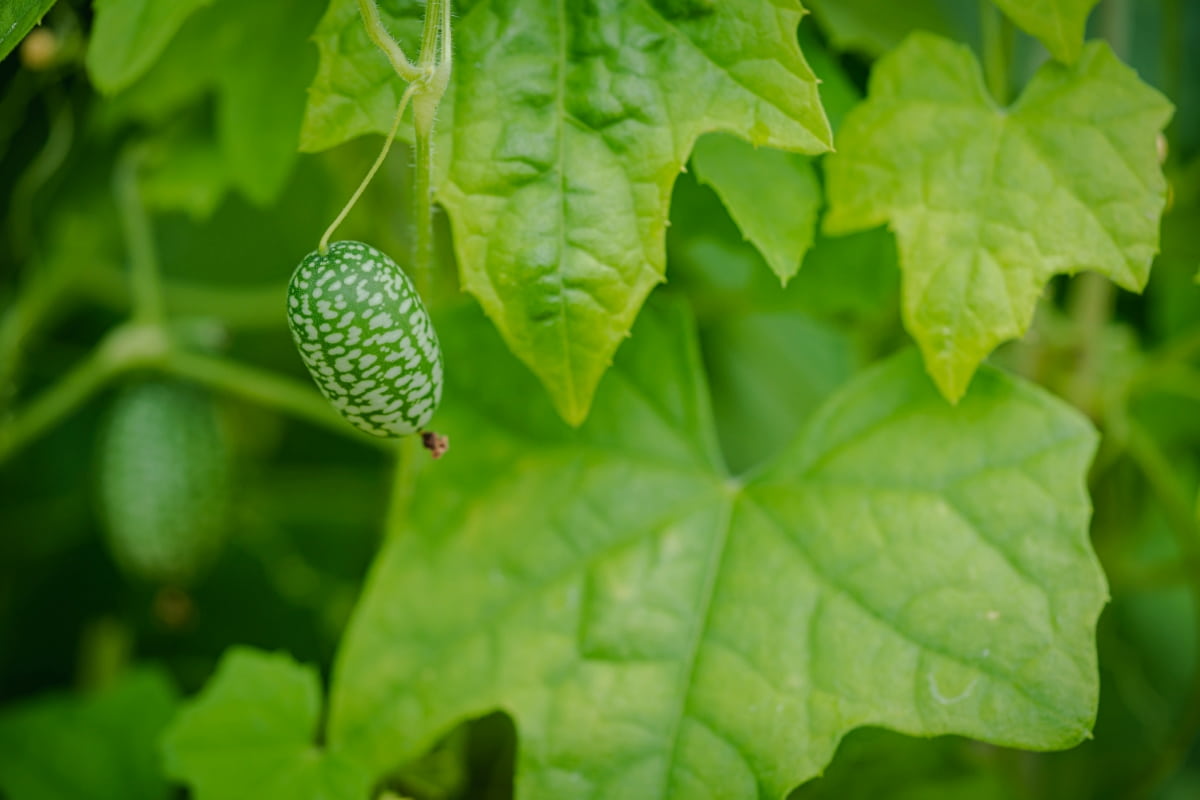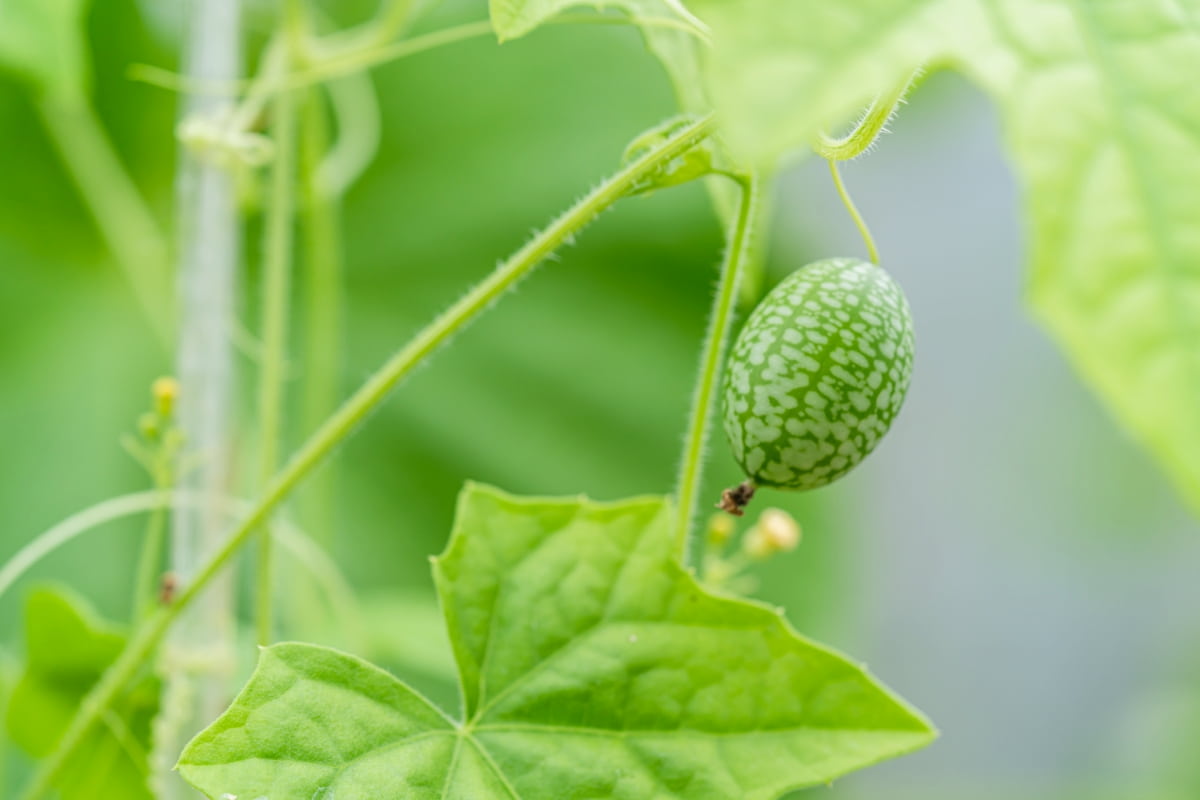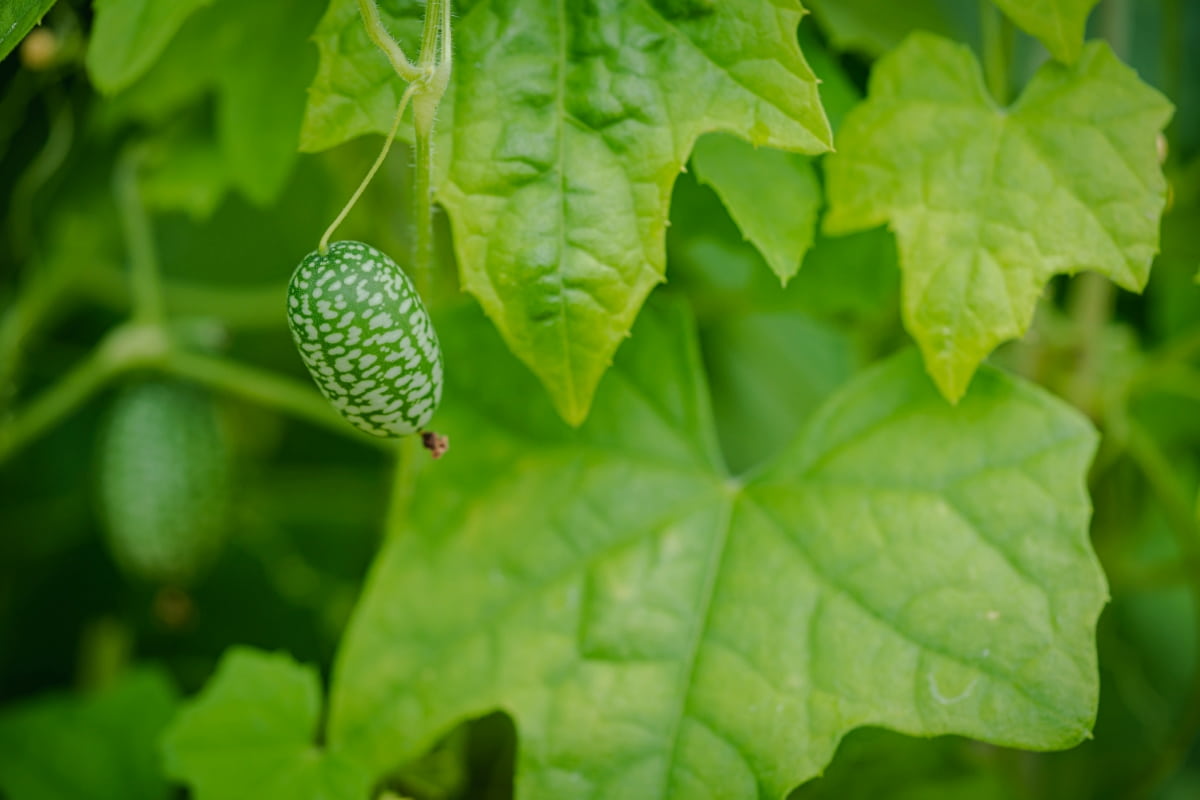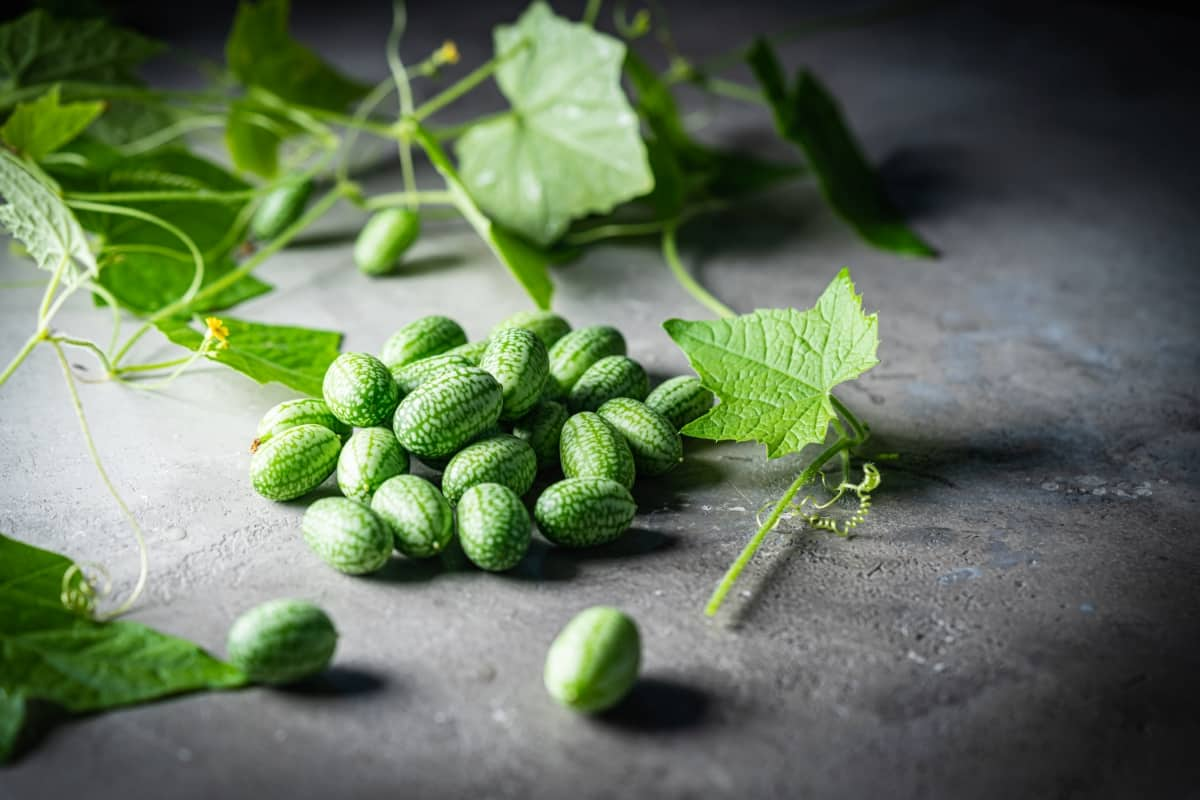Mexican Sour Gherkins, commonly called cucamelons, are captivating tiny fruits resembling mini watermelons, yet they have the flavor of cucumbers with a touch of lime. Originating from Central America, these little gems have become increasingly popular among gardeners and food enthusiasts.

One might wonder, “What temperature do Mexican Sour Gherkins grow in?” or “Do cucamelons need a trellis?” and even about the “Cucamelon growing stages.” All these questions indicate the growing interest in these bite-sized delights. Throughout this article, we’ll deeply dive into every facet of growing these fascinating fruits, from selecting the best seeds to harvesting and storing the yield.
How to Grow Mexican Sour Gherkins from Seed
Selecting the Right Seeds: Tips for Choosing High-Quality Mexican Sour Gherkin Seeds
Choosing high-quality Mexican Sour Gherkin seeds is the first step to ensure a healthy and productive plant. The best way to germinate cucamelon seeds starts with ensuring they are fresh and sourced from reputable sellers. Seeds that are discolored, shrunken, or appear damaged should be avoided. In some cases, you might encounter the issue of cucamelon seeds not germinating. This can be attributed to either being too old or improperly storing seeds. By prioritizing the quality of your seeds, you’re setting the stage for a successful growing experience.
Preparing the Soil: Creating the Ideal Growing Environment for Cucamelons
Cucamelons thrive in well-draining soil that’s rich in organic matter. Before planting cucamelon seeds, preparing the ground by working in compost or aged manure is essential. These plants thrive best in a pH range of 6.5 to 7.5. Since Mexican Sour Gherkin seedlings are sensitive, ensure the soil is loose and free from large clumps or stones. The way you prepare the soil can determine whether a plant thrives or struggles to produce.
Sowing the Seeds: Step-By-Step Guide to Planting Mexican Sour Gherkin Seeds
The journey of growing cucamelons starts with planting cucamelon seeds. Begin by sowing the seeds indoors about 4-6 weeks before the last expected frost. Plant the seeds about 0.5 inches deep in the seed-starting mix, ensuring they’re adequately spaced to avoid overcrowding. After planting, keep the soil consistently moist. As the seeds germinate and Mexican Sour Gherkin seedlings emerge, ensure they receive plenty of light to promote robust growth.
In case you missed it: How to Grow Plum from Seed: How Long Does it Take for a Plum Seed to Grow?

Providing Optimal Growing Conditions: Sunlight, Watering, and Temperature Requirements for Cucamelons
Mexican Sour Gherkins flourish under full sunlight, requiring at least 6-8 hours daily. When it comes to watering, it’s crucial to maintain consistency, ensuring the soil stays moist but not waterlogged. As for the query, “What temperature do Mexican Sour Gherkins grow in?” – they prefer warm conditions, ideally between 70-85°F (21-29°C). Providing the right temperature is crucial during the cucamelon growing stages, ensuring they develop without hindrances.
Supporting Growth: Trellising and Pruning Techniques for Mexican Sour Gherkins
As the Mexican Sour Gherkin seedlings grow, they’ll start to vine. At this stage, many gardeners ask, “Do cucamelons need a trellis?” The answer is yes. A trellis provides the necessary support for the plants, allowing them to climb and ensuring proper air circulation. In addition to using trellising, it’s advised to regularly prune the plant to eliminate any dead or diseased sections. This encourages better and more fruitful growth.
Fertilizing the Plants: Nutrient Requirements and Feeding Schedule for Cucamelons
For cucamelons to thrive and produce a bountiful harvest, they require essential nutrients. Feed the plants every 4-6 weeks with a balanced, water-soluble fertilizer. Ensure not to over-fertilize, as this can lead to lush foliage and reduced fruit production. Proper feeding ensures the plants go through their growing stages with all the necessary nourishment.
How Long Do Cucamelons Take to Grow from Seed and Cucamelon Growing Season
Patience is vital when growing cucamelons. From planting cucamelon seeds to the appearance of the first fruit, it can take around 65-75 days. The cucamelon growing season generally spans the warmer months, with the plant thriving best during late spring to early autumn. Understanding the duration and seasonality allows you to plan your planting schedule more efficiently.
In case you missed it: How to Grow Yardlong Beans from Seed: A Comprehensive Guide for Beginners

Managing Pests and Diseases: Common Issues and Effective Control Methods for Mexican Sour Gherkins
Like any garden plant, cucamelons can be susceptible to pests and diseases. Common pests include aphids, spider mites, and cucumber beetles. Regularly inspect the plants and apply organic insecticidal solutions when necessary. Cucamelons can be affected by powdery mildew and bacterial wilt when it comes to diseases. Ensure proper spacing and avoid waterlogged soil to prevent these issues. Prompt action is the key to a healthy garden.
Cucamelon Yield Per Plant/ Harvesting and Storing Cucamelons
One of the rewarding aspects of gardening is harvesting the produce. On average, the cucamelon yield per plant can range from 50-60 fruits. When harvesting, pick cucamelons when they’re about the size of large grapes, ensuring they’re firm to the touch. Store the harvested items in a cool and dry location. They can be consumed fresh, pickled, or added to various dishes, offering a delightful mix of crunch and tang.
Understanding Cucamelon Pollination: The Role of Bees and Wind
Pollination plays an essential role in the fruiting process of cucamelons. While these plants are self-pollinating, meaning they don’t necessarily need another plant for fruit production, the presence of pollinators, especially bees, can significantly boost yield. Attracting bees to your garden can be achieved by planting bee-friendly flowers nearby or providing shallow water sources. Additionally, on windy days, nature assists in pollination, as the wind can help transfer pollen between flowers. Regularly inspecting flowers and ensuring they are free from pests can further increase pollination success and subsequent fruit production.
Maximizing Growth: Techniques to Increase Cucamelon Yield
Every gardener aims to get the most out of their plants. For cucamelons, certain techniques can help optimize their yield. First, practice companion planting. Growing cucamelons alongside crops like nasturtiums can repel potential pests. Second, ensure consistent watering, especially during flowering and fruiting stages, as water stress can reduce yield. Lastly, practice regular pruning to promote more energy towards fruit production. By removing unnecessary or overgrowing vines, the plant can focus more on producing cucamelons than foliage.
From Garden to Kitchen: Culinary Uses of Cucamelons
The culinary world is your oyster once you’ve successfully harvested your cucamelons. Enjoy them as a snack, or add them to salads for a delightful crunch. Like traditional cucumbers, they can also be pickled, creating a tangy treat. Cucamelons can be used as a garnish or muddled into the drink for a refreshing flavor in cocktails or mocktails. Given their unique taste and texture, they can also be integrated into salsas or used as toppings in tacos. The possibilities are endless, and experimenting with them in the kitchen can be as enjoyable as growing them.
In case you missed it: How to Grow Capsicum from Seeds: How Long Does it Take to Grow Capsicum from Seed?

Conclusion
Growing cucamelons can be a fulfilling gardening experience with the right knowledge and care. Each step is crucial in ensuring a healthy and abundant harvest, from selecting the right seeds to understanding their unique requirements.
- Feed Your Flock for Less: Top 10 Tips to Save on Chicken Feed
- Ultimate Guide to Ossabaw Island Hog: Breeding, Raising, Diet, and Care
- Hatching Answers: The Top 10 Reasons Your Chickens Aren’t Laying Eggs
- Eggs and Economics: Breaking Down the Cost of Raising Backyard Chickens
- Defend Your Greens: Proven Methods to Keep Iguanas Out of Your Garden
- Ultimate Guide to Cinnamon Queen Chicken: A Comprehensive Guide for Beginners
- Ultimate Guide to California Tan Chicken: Breeding, Raising, Diet, Egg-Production and Care
- Ultimate Guide to Marsh Daisy Chicken: Breeding, Raising, Diet, and Care
- 10 Types of Chicken Farming Businesses You Can Start for Profits